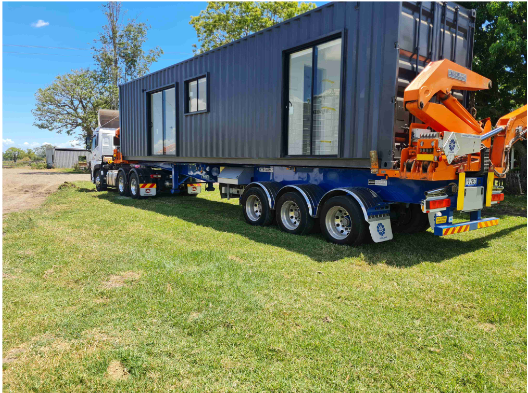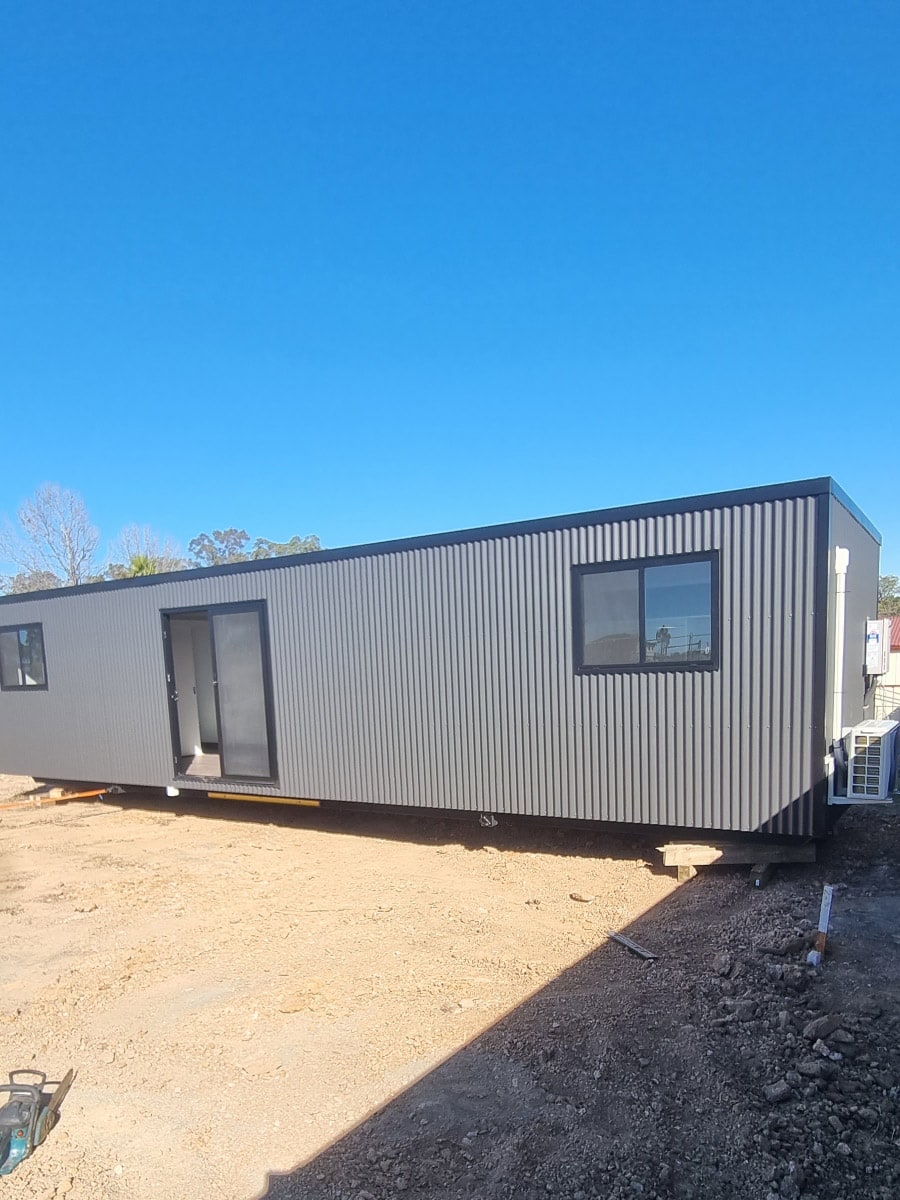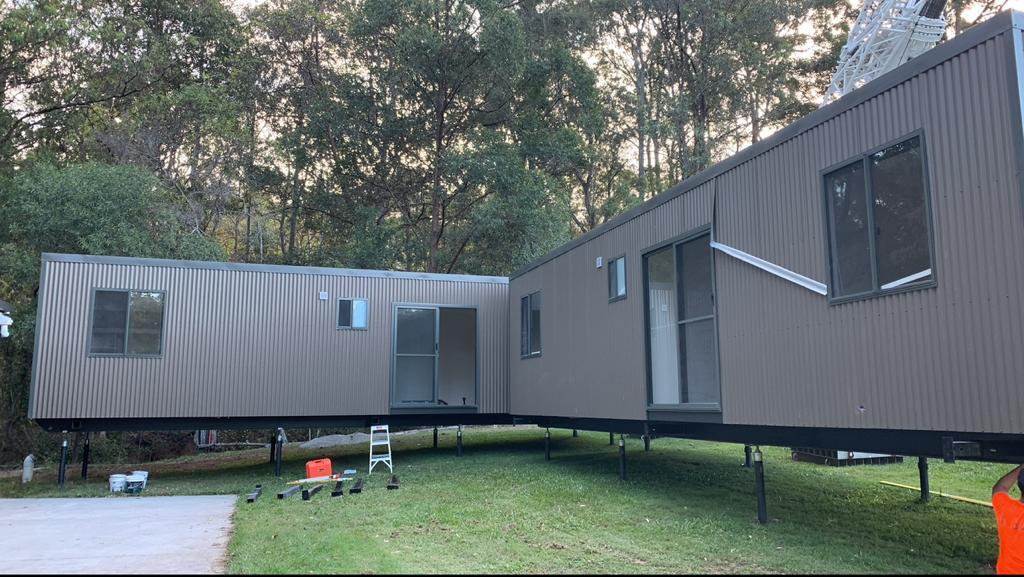Portable buildings have become an increasingly popular solution for various needs, ranging from temporary housing & emergency accommodation to office spaces. The most common question we get from our clients who enquire about hiring or purchasing our portable granny flats is whether our portable cabins fall under Class 1a under the National Construction Code (NCC) in Australia.
In this blog post, we will delve into the essential requirements for a portable building to be classified as a Class 1a. Understanding these requirements not only ensures that your portable building is safe and legally compliant but also maximizes its usability and longevity. Whether you are a homeowner looking to add a granny flat or a business owner in need of an additional office space, this comprehensive guide will provide you with everything you need to know about Class 1a portable building requirements.
We have asked our production manager, Craig Woodland, to assist us in navigating these regulations and answer key questions. We hope this will clarify the criteria necessary for a portable building to be classified as a Class 1a structure, ensuring that your project adheres to all required standards.
1. What is a Class 1a building? Can a portable granny flat be classified as a Class 1a dwelling? A Class 1a building is a standalone or attached residential structure.
For a portable building to qualify as Class 1a, it must meet all the regulatory standards set out in the Building Code of Australia (BCA), designed for permanent living accommodations. Understanding what is a Class 1a building is crucial for compliance and functionality.
2. What are the essential features a portable granny flat must have to qualify as a Class 1a dwelling?
The building must comply with AS1170 and AS1684. AS1170, known as the Structural Design Actions Standard, covers the various forces such as wind loads that the building must withstand to ensure stability under different environmental conditions. AS1684, the Residential Timber-Framed Construction Standard, provides comprehensive guidelines for the use of timber in building frameworks, ensuring safety and durability. Adherence to these standards ensures that the building can withstand local environmental conditions and meets durability and safety requirements. These are critical components of Class 1a building requirements.
3. Can a portable granny flat be connected to the main house’s utilities?
Yes, the connections must meet all relevant codes and standards, and professional installation is recommended. All our units are equipped with fresh water, grey water, and wastewater outlets. Freshwater connections, standard 50mm grey water connections, and a standard 100mm sewage connection are located at the external backside of the building. A licensed plumber can connect these outlets to the property’s mains or fresh/waste tanks using hard lines directly to the fittings. Wastewater pipes can be easily connected to your property’s wastewater system or a septic tank by a licensed plumber. Additionally, our units are equipped with a junction box containing hard wires, which a licensed electrician can use to supply and install a circuit from the main switchboard to the cabin’s junction box. Ensuring these connections meet Class 1a building requirements across Australia is essential for compliance.
4. Is there a maximum or minimum size for a portable granny flat to be classified as a Class 1a secondary dwelling?
The internal area must typically not exceed 60 square meters and maintain a minimum internal wall height of 2.4 meters. Specific room size requirements also apply, such as a minimum floor area for bathrooms and laundries. The property must be zoned residential, have a minimum area of 450m², and meet specific setback requirements from boundaries and trees. It is recommended to seek the assistance of a local Town Planner or contact your local Council to assess and ensure your site meets these requirements. Adhering to these Class 1a building requirements is necessary across different states, including Class 1a building requirements in QLD and NSW.
Read our Ultimate Guide to Council Regulations for Relocatable Granny Flats and Transportable Buildings in Australia for more information about council requirements.
5. Are there any specific plumbing and electrical standards for a Class 1a portable granny flat?
Plumbing installations must comply with AS3500 (Plumbing and Drainage), which covers the design, installation, and maintenance of plumbing and drainage systems to ensure they are safe, efficient, and sustainable. Electrical installations must comply with AS3000 (Electrical Installations – Wiring Rules), which sets out the requirements for the design, construction, and verification of electrical installations, ensuring safety and functionality in electrical systems. This ensures safe and compliant systems for water, sewage, gas, and electrical services. Meeting these Class 1a building requirements is crucial for ensuring safety and functionality.
6. How should insulation be implemented in Class 1a portable buildings to meet Australian standards?
Insulation in Class 1a portable buildings must meet AS4859, Materials for the Thermal Insulation of Buildings. AS4859 specifies the requirements for materials used in thermal insulation to ensure they provide adequate thermal resistance. The standard includes specifications for R-values, which measure the thermal resistance of the insulation material. The R-value indicates the material’s ability to resist heat flow—the higher the R-value, the better the insulation’s effectiveness. Insulation must be appropriate for the climate zone to ensure effective thermal performance, maintaining comfort and energy efficiency in the building. Ensuring insulation meets these standards is part of the broader Class 1a building requirements.
See our portable cabins for
7. What are the interior finish requirements for Class 1a portable buildings?
Interior finishes should be selected based on durability, ease of maintenance, and compliance with fire safety regulations. To ensure compliance with fire safety regulations, materials should be non-combustible or fire-rated. Common choices include plasterboard, MDF panels, or other fire-rated materials. Fire safety regulations can be found in the Building Code of Australia (BCA) and relevant Australian Standards such as AS1530, which outline testing methods and performance criteria for fire-resistant materials. It is essential to consult these regulations and, if necessary, seek advice from a fire safety professional to ensure all materials meet the required standards. This is crucial for meeting Class 1a building requirements in various states, including Class 1a building Victoria and NSW.
8. What specific fire safety measures are required for Class 1a portable buildings?
Class 1a portable buildings must include fire-resistant materials in construction, compartmentalization to limit fire spread, and smoke alarms installed according to AS3786. AS1530, Methods for Fire Tests on Building Materials, Components, and Structures, specifies the testing methods and performance criteria for fire-resistant materials. AS3786, Smoke Alarms, details the requirements for the design, installation, and performance of smoke alarms to ensure early detection of fires. These standards can be accessed through Standards Australia or local regulatory authorities. Ensuring compliance with these standards is crucial for the safety and legal adherence of the building.
9. How is acoustic insulation managed in Class 1a portable buildings to control sound transmission?
Acoustic performance must meet the BCA requirements, using materials and construction methods that reduce airborne and impact sound transmission. This includes specialized acoustic insulation materials that absorb and block sound waves, double-glazed windows that provide an additional barrier to sound, and solid internal doors that prevent sound from passing through. Implementing these measures helps to create a quieter and more comfortable living environment within the portable building. Additional measures such as resilient channels and soundproofing mats can further enhance the acoustic performance of the building. This is part of the Class 1a building requirements to ensure a comfortable living space.
10. What energy efficiency measures must be incorporated into Class 1a portable buildings?
Energy efficiency is governed by BCA Section J, which necessitates that buildings minimize energy use through effective thermal performance. This includes:
- Selecting the Correct Insulation Materials: Ensuring insulation meets the appropriate R-values for the climate zone.
- Installing High-Performance Windows: Windows must comply with AS2047, which specifies the requirements for the design, performance, and testing of windows and external glazed doors to ensure they meet energy efficiency and safety standards.
- Integrating Passive Design Elements: Strategic window placement, shading devices, and orientation to maximize natural light and ventilation while minimizing heat gain in summer and heat loss in winter.
These measures collectively improve the thermal performance of the building, reducing energy consumption for heating and cooling, and enhancing overall comfort. Meeting these energy efficiency requirements is a key aspect of the Class 1a building requirements.
11. What documentation is required to demonstrate compliance with Class 1a standards for a portable building?
The required documentation typically includes:
- Detailed Plans and Specifications: Essential for all projects.
- Engineering Certificates: Required for structural verification.
- Compliance with Australian Standards: Must be provided.
- Energy Efficiency Reports: Required to demonstrate compliance with energy performance standards.
- Certificate from an Accredited Building Certifier: Sometimes required, depending on the area.
These documents are crucial for demonstrating compliance with Class 1a building requirements across various regions, including Class 1a building requirements QLD, NSW and Victoria.
12. Can a portable granny flat classified as a Class 1a dwelling be relocated?
Yes, provided it is designed for portability and reinstallation complies with AS3007 for Transportable Buildings and local regulations. AS3007 sets out the requirements for the design, construction, and installation of transportable buildings to ensure they are safe and functional when moved to a new location. The process includes ensuring the structure remains compliant with all relevant standards at the new location, such as securing necessary permits, verifying the integrity of the building after transport, and making any required updates to meet local building codes and regulations. This is essential to maintain compliance with Class 1a building requirements.
Still have any questions or ready to hire or purchase a portable granny flats, contact PennyGranny’s customer support team now.
Here are some helpful links that can provide you with more in-depth knowledge about Class 1a building requirements:
- This link provides access to the National Construction Code, which includes the Building Code of Australia (BCA): National Construction Code (NCC)
- Detailed information on building regulations and standards in QLD, including those for Class 1a buildings: Queensland Government
- New South Wales Government: Planning Portal
- Victorian Building Authority (VBA) – Building Regulations
Ensuring your portable building meets the Class 1a classification under the National Construction Code (NCC) is crucial for safety and compliance. This guide has detailed the necessary requirements to help you achieve this standard, guaranteeing that your portable building is legally compliant, safe, and functional for its intended use. Should you have further questions or need professional assistance, our team is ready to support you throughout your project, ensuring it meets all essential standards and requirements.
Discover our full range of cabins available for hire or purchase by visiting our website. With Penny Granny, your next step toward temporary or permanent housing is just a consultation away. Interested in exploring your options or seeking more information? Visit our Contact Page for all your inquiries.
















































